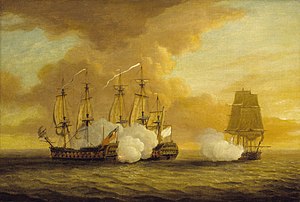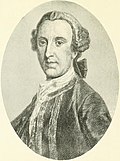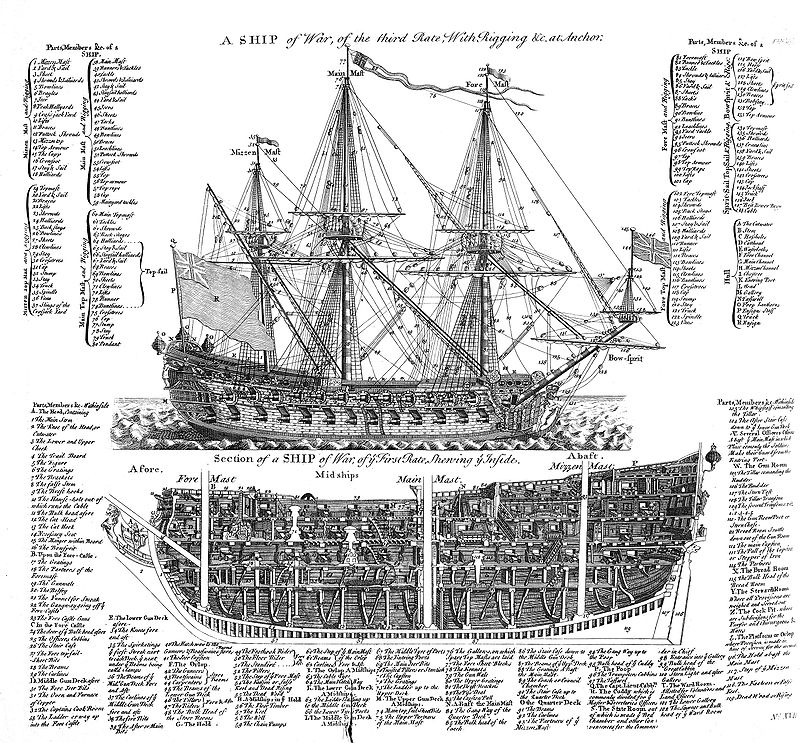HMSLion(1709)
 HMSLionattacks two French vessels carrying Prince Charles onboard, 9 July 1745
| |
| History | |
|---|---|
| Name | HMSLion |
| Builder | Rosewell, Chatham Dockyard |
| Launched | 20 January 1709 |
| Honours and awards | Second Battle of Cape Finisterre,1747 |
| Fate | Sold, 1765 |
| General characteristics as built[1] | |
| Class and type | 1706 Establishment60-gunfourth rateship of the line |
| Tons burthen | 914 bm |
| Length | 144 ft (43.9 m) (gundeck) |
| Beam | 38 ft (11.6 m) |
| Depth of hold | 15 ft 8 in (4.8 m) |
| Propulsion | Sails |
| Sail plan | Full-rigged ship |
| Armament |
|
| General characteristics after 1738 rebuild[2] | |
| Class and type | 1733 proposals60-gun fourth rate ship of the line |
| Tons burthen | 1,068 bm |
| Length | 144 ft (43.9 m) (gundeck) |
| Beam | 41 ft 5 in (12.6 m) |
| Depth of hold | 16 ft 11 in (5.2 m) |
| Propulsion | Sails |
| Sail plan | Full-rigged ship |
| Armament |
|
HMSLionorLyonwas a 60-gunfourth rateship of the lineof theRoyal Navy,built atChatham Dockyardto the1706 Establishmentand launched on 20 January 1709.[1]
Career
[edit]On 17 October 1709 Capt.Galfridus Walpole,the youngest son of SirRobert Walpole,was appointed captain ofLion(50 cannons). He maintained that post till 1714.[3][4]
On 22 March 1711,Lionwas with other Royal Navy vessels inVado Bayon the Italian coast when four French enemy ships were sighted. She and others gave chase and engaged the enemy for about two hours. Forty ofLion's crew were killed, and Walpole was so badly injured that his right arm was amputated by the ship's surgeonJohn Atkins.[5][6]Walpole's sword from the time of this engagement was subsequently gifted to a youngHoratio Nelsonand was still in his possession when he too lost his right arm in theBattle of Santa Cruz de Tenerifeon 15 July 1797.[7][8]
In September 1712, together withHMSCornwall,MaryandHMSSuperb,assisted AdmiralJohn Jenningswith landing troops atBarcelona.[9]
On 9 December 1735 orders were issued forLionto be dismantled and rebuilt according to the1733 proposalsof the1719 EstablishmentatDeptford,from where she was relaunched on 25 April 1738.

During theJacobite risingshe saw action on 9 July 1745, when she exchanged fire with the French ships Elizabeth and theDu Teillay.[10]TheLionis described as 58 guns with a crew of 400.[11]TheDu Teillayat the time was carryingCharles Edward Stuartto Scotland with supplies and funds to support his cause. Prince Charles had boarded the French ship on 7 July atSaint-Nazairebound forArdmolich;they were joined by a French escort ship theElizabeth(L'Elisabeth). Two days later they were intercepted by theLion,commanded by CaptainPiercy Brett.A close action began at 17:00 between theLionandElizabeth,with theDu Teillayattacking theLionseveral times and, at 18:00, theLions’ mizzen topmast came down. By 20:00, TheLionwith her mizzen top and topmast shot away and hanging over the side was still in close action with theElizabeth.TheDu Teillayshielded by theElizabethcontinued firing at theLion,who returned fire with her stern guns. TheLioncontinued firing at theElizabethuntil the latter broke free at 22:00 to join theDu Teillay;by this time theLionwas too damaged to follow (she had also taken extensive damage to the hull); with 45 of her men dead and about 107 wounded. TheElizabethhad lost about 57 men with 175 wounded, her commander, Captain Dau, among the dead. On 2 August 1745, theDu Teillaylanded Charles Stuart atEriskay,and then ontoLoch nan Uamh,Scotland, before returning to France.
Captain Brett, who was wounded in the battle, was obliged to have the captain of the Marines arrested for skulking on the poop under cover of some bags, setting such a bad example that it encouraged most of his men to do likewise.[12]Dominic Serrespainted a version of the event in 1860, from three drawings done at the time by Peircy Brett.
In April 1747Lionwas part of a small squadron under the overall command of Thomas Fox onHMSKent,consisting ofHMSHampton Court,HMSEagle,HMSChester,HMSHector,and twofireships.They cruised betweenUshantandCape Finisterrein an attempt to intercept a large merchant fleet that was sailing fromSan Domingoto France. After a month at sea they encountered the convoy, which consisted of some 170 ships carrying a cargo ofcochineal,cotton,indigoand other valuable commodities. They were escorted by four French warships, who fled upon the approach of the British fleet. Fox's squadron captured 46 merchants, and dispersed the rest. Some were later captured by smaller British warships operating in the area.
In January 1748Charles Watsonwas appointed commander-in-chief of theNewfoundland and North American stationwith his flag in HMSLion.[13]
Lioncontinued in service until 1765, when she was sold out of the navy.[2]

Notes
[edit]- ^abLavery, Ships of the Line vol.1, p168.
- ^abLavery, Ships of the Line vol.1, p171.
- ^"Galfridus Walpole (d. 1726)".ThreeDecks.org.Retrieved25 July2014.
- ^"Galfridus Walpole appointed Captain".WRECK site.WRECK site.Retrieved7 December2016.
- ^Clowes, William Laird(1898).The Royal Navy, a history from the earliest times to the present.London: Sampson Low, Marston and Company. p. 531.
- ^Moore, Norman(1885)..InStephen, Leslie(ed.).Dictionary of National Biography.Vol. 2. London: Smith, Elder & Co.
- ^Nevill, Lady Corothy (1894).Mannington and the Walpoles(PDF).London:Fine Art Society.pp. 13–14.
- ^"Florence, September 6th",The London Gazette(5053): 1, 20–23 September 1712
- ^http://collections.rmg.co.uk/collections/objects/11856.htmlNational Maritime Museum
- ^Perrin, William Gordon (1928).The Naval Miscellany Vol 63.Google Books: Navy Records Society. pp. 102, 103.Retrieved7 December2016.
- ^"Peircy Brett letter to the Admiralty". 30 July 1745.
{{cite journal}}:Cite journal requires|journal=(help) - ^"Oxford Dictionary of National Biography of Charles Watson".Oxford Dictionary of National Biography(online ed.). Oxford University Press. 2004.doi:10.1093/ref:odnb/28831.Retrieved8 December2016.(Subscription orUK public library membershiprequired.)
References
[edit]- Colledge, J. J.;Warlow, Ben (2006) [1969].Ships of the Royal Navy: The Complete Record of all Fighting Ships of the Royal Navy(Rev. ed.). London: Chatham Publishing.ISBN978-1-86176-281-8.
- Lavery, Brian (2003)The Ship of the Line – Volume 1: The development of the battlefleet 1650-1850.Conway Maritime Press.ISBN0-85177-252-8.
- Michael Phillips.Kent(70) (1746).Michael Phillips' Ships of the Old Navy. Retrieved 9 August 2008.
